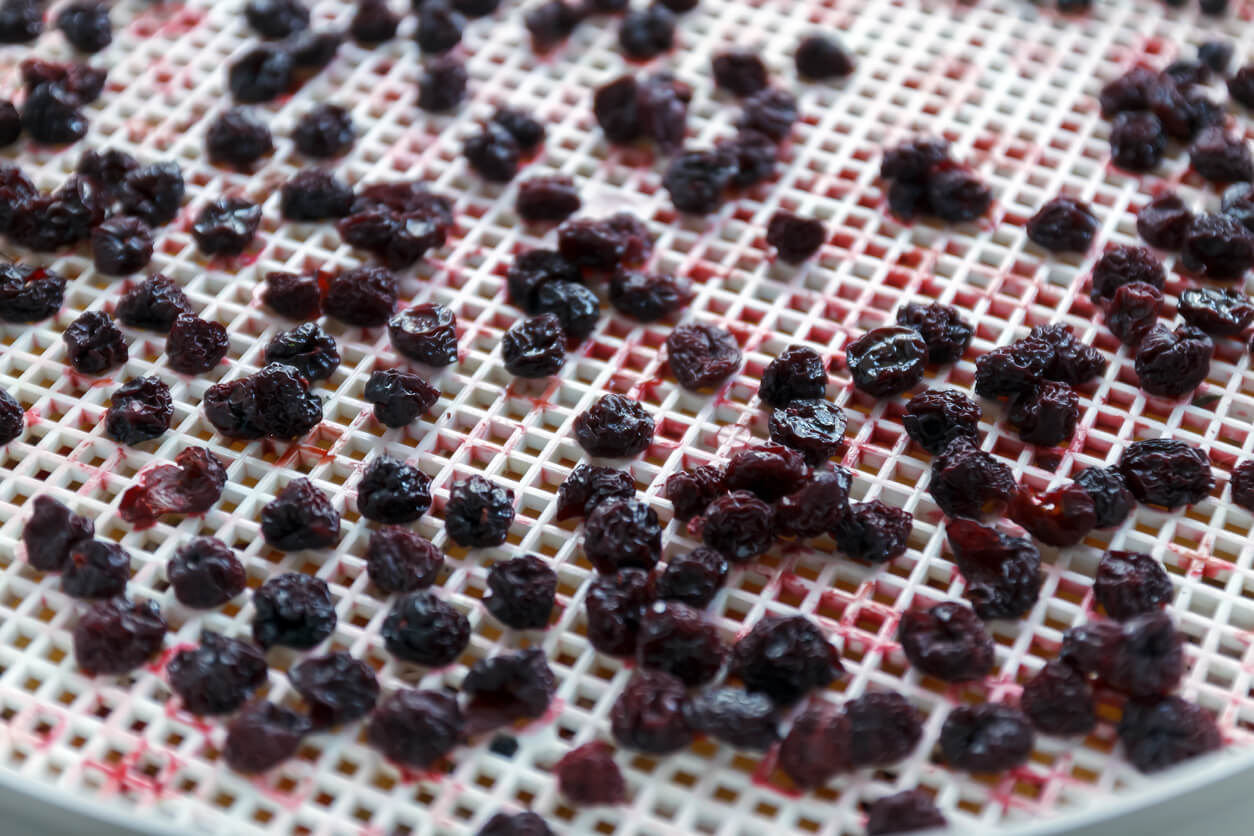
Cherries dried in a dehydrator
If you have a good harvest year, it’s entirely possible that you’ll wind up with more cherries than you know what to do with. Cherries are delicious, but how many bowls of fresh cherries can you eat?
Use these tips to store your cherries to taste their best and to preserve the batches that are left over.
Sort Your Cherries
Your first step is to sort through your harvested cherries. Discard any that are bruised, soft, or damaged. One spoiled cherry can spoil the whole bunch. Don’t wash cherries until just before you’re ready to eat them. Cherries retain moisture, and moisture encourages rot and mold.
Refrigerate Your Cherries
Put your unwashed cherries in a dish or on a baking sheet in a single layer, and store them in the coldest, darkest part of your fridge. Don’t seal them up in a bag or a storage container; you want to avoid having them get damp. And because cherries are so good at absorbing moisture from other sources, try to store them in a crisper drawer or somewhere away from any strong-smelling foods you may have in the fridge.
Freeze Your Cherries
Freezing is one of the most convenient ways to preserve cherries. Wash and pit them first; you’ll be happier when you take them out of the freezer. Take pitted cherries and flash freeze them in a single layer on a parchment-lined baking sheet; this will help prevent them from sticking together in the freezer. Transfer the cherries to an airtight container. When you’re ready to use them, just pop them out to thaw. If you need a precise measure of cherries, be sure to do that while they’re still frozen; once they thaw, you’ll get more than you bargained for. Use in baking, cooking, smoothies, and more.
Dehydrate Your Cherries
Dried cherries are a delicious treat on their own. They’re also good in granola, salads, baked goods, and more. Wash and pit your cherries and cut them in half. Arrange the cut cherries, cut side up, in a single layer. Use a dehydrator (24 to 36 hours), set them out in the sun where they’re safe from birds and bugs (12 hours to five days), or put them in the oven at 130 to 180 degrees F (six to 24 hours).
Can Your Cherries
Canning is a time-honored preservation method—and one you should only pursue if you have the right equipment. You must be careful to follow all canning directions to the letter in order to avoid botulism in your canned goods. Check out our post in Food Gardening Daily that provides Pressure Canning Safety: 10 rules to live by.
Prepare Cherry Vinegar
Flavored vinegar makes a great gift, and it’s great to have on hand to give salads and other dishes some extra sparkle. Just get an inexpensive bottle of balsamic vinegar. Put ripe, washed, pitted cherries into a glass container with a tight-fitting lid (a canning jar is a good choice). Mash the cherries with a fork or muddler. Cover the mashed cherries with balsamic vinegar. Seal the jar and put it in the back of a cabinet (or another cool, dark spot) for at least a week (some folks have left the cherries soaking for a year or more). Give it a taste test; when you’re happy with the taste, strain the cherries and put the freshly flavored vinegar into a clean jar or bottle. Store tightly sealed in a cool, dark spot. Use the leftover cherries in a dinner dish or leave them in the vinegar.
Make Cherry Fruit Leather
Fruit leather is delicious, especially if you make it yourself! Take ripe or slightly overripe cherries, wash, pit, and drain them, then purée them in a blender or food processor. If you want sweetener, use sugar for fruit leather you plan to eat right away. Use corn syrup or honey for fruit leather you want to store; corn syrup and honey don’t crystallize like sugar does. Bring your cherry purée (with optional sweetener) to a boil; let it cool down until it’s warm. Line baking sheets with plastic wrap (don’t forget to smooth out the wrinkles!). Pour your purée onto the baking sheet in a layer about 1/4 inch thick. Dry it in the oven at the lowest setting (130 to 180 degrees F). Leave the oven door open slightly and check your cherry leather every few hours; it may take up to 18 hours for it to fully dry. You’ll know it’s ready when the surface of the fruit leather is dry but tacky. If you have a dehydrator, spread the purée to a thickness of only 1/8 inch and dry for six to eight hours. Cool, slice, and re-wrap in plastic. Store uneaten fruit leather in the fridge in an airtight container.
A Warning About Cherry Pits
Pits are the price you pay for enjoying cherries. Just be sure to keep the pits out of food: not only are they a choking hazard, they can be poisonous. The core of the cherry pit contains cyanide. Ingesting just a few crushed cherry pits can be fatal.
What’s your favorite way to store and preserve your cherry harvest? How much do you preserve compared to how much you eat fresh? Please share your best tips for storing and preserving cherries.


 Previous
Previous

